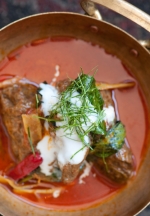Panangs of Authenticity in Camden, Maine

Recipe
Photos
Born in Thailand, Ravin Nakjaroen has cooked in the United States for more than 15 years. And from his restaurant Long Grain in Camden, Maine, he is saving Thai food from the evil banality that has muted its flavors and squashed Thai tradition. Far from the sad, strip-mall "palaces" and corner joints that dot American suburbs and cities, Nakjaroen is making things right, 30 guests at a time. His intense, spicy, salty, sweet, aromatic curry paste is the slap-you-upside-the-head soul of his Panang Curry. Cumin seeds must be invited to the Panang party as well, according to Nakjaroen, or else you'll be left with a real Debbie Downer of a dish.
"It’s one of the most misrepresented curries in this country. Panang Curry served in America is very soup-like. It's too light with too much coconut milk, too little curry paste, and always comes with mixed vegetables and sprinkled with crushed peanuts," says Chef Ravin Nakjaroen. "And it's always missing the key ingredient: kaffir lime leaves.”

Panang Curry

Garlic-Chive Rice Cake with Sauteed Bean Sprouts and Red Chile Sauce

Chef Ravin Nakjaroen of Long Grain - Portland, ME
Glossy kaffir lime leaves (the ones that look like two leaves fused into one) have a delicate fragrance that stands in sharp contrast to the noticeable flavor (citrus, sour, touch of bitterness) it adds to Southeast Asian soups, stews, and curries. The mouthfeel it generates is also particular: astringent, similar to red wine tannins. It’s a feel and flavor that gives Panang curry its backbone, distinctiveness, and ultimately an identity all its own. The personality kaffir lime leaves offer can’t be duplicated with zest or juice or even leaves from a different lime tree—they’re a thin disguise.
“At Long Grain we do it the traditional way: braised beef, like a stew, very thick, and the key—kaffir lime leaves—must be there. We want to make sure people know this is the way it's supposed to be," says Nakjaroen.
Fattier cuts of beef are another authentic component of Panang curry that Nakjaroen insists upon, "We use beef chuck!" The beef absolutely must be slow cooked, and the curry (not curry soup!) should always be finished with just a splash of coconut cream and plenty fine kaffir chiffonande and Thai basil to send guests on a sentient journey to the streets Bangkok.
"Panang curry is not a fancy dish back home. It's served in the home, but more often it's found as street food than in a restaurant." From the fragrant roasting of spices, to the shrimp paste, chiles, and palm sugar, here's the exact technique for Nakjaroen's Panang curry, what he refers to as, "the true version," best served a day or two after braising to really help the flavors of Thailand sing.
Panang Curry Technique
- Toast all your spices until fragrant: white peppercorns, coriander seeds, cumin seeds—you MUST have cumin seeds!
- Grind cooled spices to powder then purèe with kaffir lime leaves(!), chiles (New Mexico reds), lemon grass, shallots, galangal, garlic, shrimp paste, roasted peanuts, and sea salt to a paste.
- Sauté paste until fragrant then add coconut milk and simmer five minutes.
- Add beef chuck and kaffir lime leaves, followed by fish sauce, palm sugar, and more coconut milk; simmer 5 minutes. Adjust seasoning with additional fish sauce and sugar, if necessary.
- Braise 2 hours.
- Best served after a day to 2.
- Reheat and stir in sliced Fresno chiles and Thai basil. Garnish with drizzle of coconut cream, chiffonade of kaffir lime leaves, and more basil.








